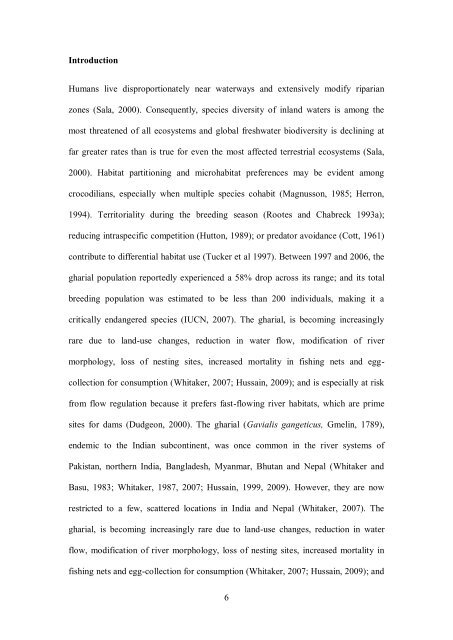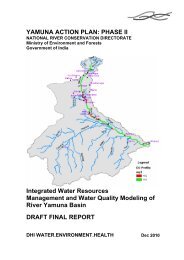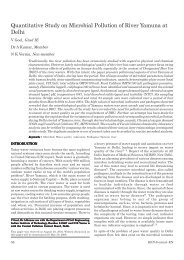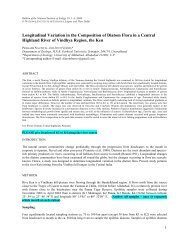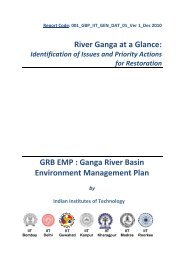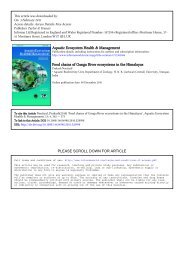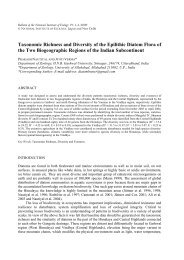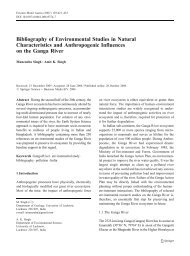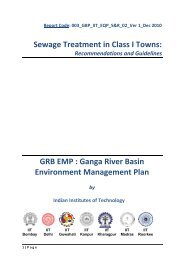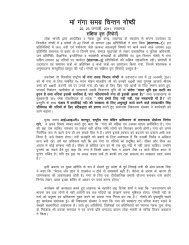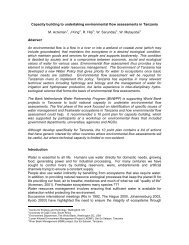Ecological and anthropogenic covariates ... - GANGAPEDIA
Ecological and anthropogenic covariates ... - GANGAPEDIA
Ecological and anthropogenic covariates ... - GANGAPEDIA
You also want an ePaper? Increase the reach of your titles
YUMPU automatically turns print PDFs into web optimized ePapers that Google loves.
Introduction<br />
Humans live disproportionately near waterways <strong>and</strong> extensively modify riparian<br />
zones (Sala, 2000). Consequently, species diversity of inl<strong>and</strong> waters is among the<br />
most threatened of all ecosystems <strong>and</strong> global freshwater biodiversity is declining at<br />
far greater rates than is true for even the most affected terrestrial ecosystems (Sala,<br />
2000). Habitat partitioning <strong>and</strong> microhabitat preferences may be evident among<br />
crocodilians, especially when multiple species cohabit (Magnusson, 1985; Herron,<br />
1994). Territoriality during the breeding season (Rootes <strong>and</strong> Chabreck 1993a);<br />
reducing intraspecific competition (Hutton, 1989); or predator avoidance (Cott, 1961)<br />
contribute to differential habitat use (Tucker et al 1997). Between 1997 <strong>and</strong> 2006, the<br />
gharial population reportedly experienced a 58% drop across its range; <strong>and</strong> its total<br />
breeding population was estimated to be less than 200 individuals, making it a<br />
critically endangered species (IUCN, 2007). The gharial, is becoming increasingly<br />
rare due to l<strong>and</strong>-use changes, reduction in water flow, modification of river<br />
morphology, loss of nesting sites, increased mortality in fishing nets <strong>and</strong> egg-<br />
collection for consumption (Whitaker, 2007; Hussain, 2009); <strong>and</strong> is especially at risk<br />
from flow regulation because it prefers fast-flowing river habitats, which are prime<br />
sites for dams (Dudgeon, 2000). The gharial (Gavialis gangeticus, Gmelin, 1789),<br />
endemic to the Indian subcontinent, was once common in the river systems of<br />
Pakistan, northern India, Bangladesh, Myanmar, Bhutan <strong>and</strong> Nepal (Whitaker <strong>and</strong><br />
Basu, 1983; Whitaker, 1987, 2007; Hussain, 1999, 2009). However, they are now<br />
restricted to a few, scattered locations in India <strong>and</strong> Nepal (Whitaker, 2007). The<br />
gharial, is becoming increasingly rare due to l<strong>and</strong>-use changes, reduction in water<br />
flow, modification of river morphology, loss of nesting sites, increased mortality in<br />
fishing nets <strong>and</strong> egg-collection for consumption (Whitaker, 2007; Hussain, 2009); <strong>and</strong><br />
6


